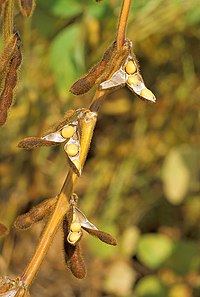
Photo from wikipedia
BACKGROUND Soybean (Glycine max) is high in proteins and isoflavones that offer many benefits to human health, while the fermentation process suggested enhancing the nutrients of the soybeans. Organic foods… Click to show full abstract
BACKGROUND Soybean (Glycine max) is high in proteins and isoflavones that offer many benefits to human health, while the fermentation process suggested enhancing the nutrients of the soybeans. Organic foods are perceived as better than non-organic in terms of health benefits, yet little is known about the difference in the phytochemical contents that discriminate the quality of organic from non-organic soybeans. In this study, the chemical profiles of non-organic (G, T, U, UB) and organic (C, COF, A, R, B, Z) soybeans (Glycine max [L.] Merr.) and their metabolite changes after fermentation with Rhizopus oligosporus were investigated. RESULTS A clear separation was only observed between non-organic G and organic Z which were then selected for further investigation in the fermentation of soybeans (GF and ZF). All four groups (G, Z, GF, ZF) were analyzed using NMR along with LC-MS/MS, wherein a total of 41 and 47 metabolites were identified respectively, with 12 in common. A clear variation (|log1.5 FC| > 2 and p < 0.05) was observed between Z and ZF, whereby most of the sugars and isoflavone glycosides are found only in Z, while more amino acids and organic acids are found in ZF. Additional four metabolites clustered as C-glycosylflavonoids were discovered from MS/MS-based molecular networking. CONCLUSION Chemical profiles of non-organic and organic soybeans exhibited no significant difference. However, the metabolites profile of the unfermented soybean that is higher in sugars shifted to higher amino acids and organic acids after fermentation, thereby potentially enhancing their nutritional value. This article is protected by copyright. All rights reserved.
Journal Title: Journal of the science of food and agriculture
Year Published: 2022
Link to full text (if available)
Share on Social Media: Sign Up to like & get
recommendations!